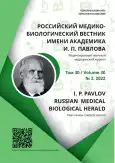Comparative Assessment of the Results of Different Techniques of Carotid Bifurcation Reconstruction
- Authors: Beloyartsev D.F.1
-
Affiliations:
- A. V. Vishnevsky National Medical Research Center of Surgery
- Issue: Vol 30, No 2 (2022)
- Pages: 271-278
- Section: Reviews
- URL: https://journals.rcsi.science/pavlovj/article/view/104394
- DOI: https://doi.org/10.17816/PAVLOVJ104394
- ID: 104394
Cite item
Abstract
INTRODUCTION: Nowadays, to restore the patency of the carotid artery bifurcation in atherosclerotic stenoses, three main methods of reconstruction are used, namely, classic carotid endarterectomy (cCEAE), prosthetic repair of the internal carotid artery, and eversion carotid endarterectomy (eCEAE). The study conducted a comparative analysis of the immediate and long-term results of using these methods in the case of stenosis of the carotid artery bifurcation.
CONCLUSION: As regards the immediate results, the analysis of literature does not permit allow making an unambiguous conclusion about the evident advantages of a particular method of intervention. Thus, several authors obtained better results with the use of eCEAE, whereas others did not find any significant differences between eCEAE and cCEAE, if it was not a question about using a straight seam, and this can be referred to both meta-analyses and original studies. Regarding the long-term results, practically all literary sources indicate more optimal results with the use of the eversion technique. The results of the analysis imply the preference for eCEAE if the character of the lesion of the carotid bifurcation and anatomical interrelations in the surgical wound allow it.
Full Text
##article.viewOnOriginalSite##About the authors
Dmitry F. Beloyartsev
A. V. Vishnevsky National Medical Research Center of Surgery
Author for correspondence.
Email: beloyar@rambler.ru
ORCID iD: 0000-0002-7808-3454
SPIN-code: 6165-3667
MD, Dr. Sci. (Med.), Professor
Russian Federation, MoscowReferences
- Trisal V, Paulson T, Hans SS, et al. Carotid artery restenosis: an ongoing disease process. The American Surgeon. 2002;68(3):275–80.
- Darling RC 3rd, Mehta M, Roddy SP, et al. Eversion carotid endarterectomy: a technical alternative that may obviate patch closure in women. Cardiovascular Surgery. 2003;11(5):347–52. doi: 10.1016/S0967-2109(03)00076-0
- Duncan JM, Reul GJ, Ott DA, et al. Outcomes and risk factors in 1,609 carotid endarterectomies. Texas Heart Institute Journal. 2008;35(2):104–10.
- DorigoW, Pulli R, Pratesi G, et al. Early and long-term results of carotid endarterectomy in diabetic patients. Journal of Vascular Surgery. 2011;53(1):44–52. doi: 10.1016/j.jvs.2010.08.030
- Radak D, Tanasković S, Matić P, et al. Eversion carotid endarterectomy ― our experience after 20 years of carotid surgery and 9897 carotid endarterectomy procedures. Annals of Vascular Surgery. 2012;26(7):924–8. doi: 10.1016/j.avsg.2011.09.011
- Ballotta E, Toniato A, Da Giau G et al. Durability of eversion carotid endarterectomy. Journal of Vascular Surgery. 2014;59(5):1274–81. doi: 10.1016/j.jvs.2013.11.088
- Raithel D. Would a surgeon operate on patients at ‘high risk’ of surgery? In: Greenhalgh RM. Vascular and endovascular challenges. BIBA Publishing; 2004. P. 69–75.
- Ricco JB, Marchand C, Neau JP, et al. Prosthetic carotid bypass grafts for atherosclerotic lesions: a prospective study of 198 consecutive cases. European Journal of Vascular and Endovascular Surgery. 2009;37(3):272–8. doi: 10.1016/j.ejvs.2008.11.012
- Fokin AA, Babkin EV. Infectious complications of reconstructive operations on carotid arteries in atherosclerotic stenoses. Angiology and Vascular Surgery. 2010;16(2):87–90. (In Russ).
- Kang J, Conrad MF, Patel VI, et al. Clinical and anatomic outcomes after carotid endarterectomy. Journal of Vascular Surgery. 2014;59(4):944–9. doi: 10.1016/j.jvs.2013.10.059
- Kazantsev AN, Chernykh KP, Lider RYu, et al. Comparative results of conventional and eversion carotid endarterectomy. Kardiologiya i Serdechno-Sosudistaya Khirurgiya. 2020;13(6):550–5. (In Russ). doi: 10.17116/kardio202013061550
- Kazanchyan PO, Popov VA, Larkov RN, et al. Comparative evaluation of classical and eversion methods of carotid endarterectomy. Angiology and Vascular Surgery. 2002;8(3):81–6. (In Russ).
- Sedov VM, Batalin IV, Kondratiev VM. Relationship between the results of the treatment of patients with cerebral artery atherosclerosis and technology of carotid endarterectomy. Angiology and Vascular Surgery. 2004;10(1):111–5. (In Russ).
- Belov YuV, Stepanenko AB, Gens AP, et al. Protezirovanie sonnykh arteriy. Khirurgiya. Zurnal imeni N.I. Pirogova. 2005;(8):36–40. (In Russ).
- Antonopopulos CN, Kakisis JD, Sergentanis TN, et al. Eversion versus conventional carotid endarterectomy: a meta-analysis of randomised and non-randomised studies. European Journal of Vascular and Endovascular Surgery. 2011;42(6):751–65. doi: 10.1016/j.ejvs.2011.08.012
- Paraskevas KI, Robertson V, Saratzis AN, et al. Editor's Choice ― An Updated Systematic Review and Meta-analysis of Outcomes Following Eversion vs. Conventional Carotid Endarterectomy in Randomised Controlled Trials and Observational Studies. European Journal of Vascular and Endovascular Surgery. 2018;55(4):465–73. doi: 10.1016/j.ejvs.2017.12.025
- Beloyartsev DF. Karotidnye rekostruktsyi: evolutsija metodik i sravnitelnye resultaty. In: Revishvili AS, Chupin AV. II Mezhdunarodnaja konferencija “Sosudistaja khirurgija v Rossii: proshloe, nastojatschee, budutschee. Diagnostika I lechenie karotidnykh stenosov”. Moscow: Fabrika ophsetnoy pechati; 2021. P. 156–79. (In Russ).
- Dakour–Aridi H, Ou M, Locham S, et al. Outcomes following Eversion versus Conventional Endarterectomy in the Vascular Quality Initiative Database. Annals of Vascular Surgery. 2020;65:1–9. doi: 10.1016/j.avsg.2019.07.021
- Gavrilenko AV, Kuklin AV, Al-Yousef NN, et al. Meta-analysis of the results of eversion carotid endarterectomy and endarterectomy with patch plasty. Angiology and Vascular Surgery. 2020;26(1):176–83. (In Russ).
- Lazarides MK, Christaina E, Argyriou C et al. Editor's Choice ― Network Meta-Analysis of Carotid Endarterectomy Closure Techniques. European Journal of Vascular and Endovascular Surgery. 2021;61(2):181–90. doi: 10.1016/j.ejvs.2020.10.009
- Veldenz HC, Kinser R, Yates GN. Carotid graft replacement: a durable option. Journal of Vascular Surgery. 2005;42(2):220–6. doi: 10.1016/j.jvs.2005.04.004
- Pokrovsky AV, Beloyartsev DF, Adyrkhaev ZA, et al. Does the method of carotid reconstruction influence the outcomes of the intervention? Angiology and Vascular Surgery. 2012;18(3):81–91. (In Russ).
- Beloyartsev DF. Alternative reconstructions of carotid bifurcation for atherosclerosis: the history and the latest advances. Angiology and Vascular Surgery. 2009;15(1):117–26. (In Russ).
- Markovic DM, Davidovic LB, Cvetkovic DD, et al. Single-center prospective, randomized analysis of conventional and eversion carotid endarterectomy. The Journal of Cardiovascular Surgery. 2008;49(5):619–25.
- Kazanchian PO, Popov VA, Lar’kov RN, et al. Clinical and surgical evaluation of results of classical and eversion carotid endarterectomy. Kardiologiya i Serdechno-Sosudistaya Khirurgiya. 2009;2(6):42–6. (In Russ).
- Demirel S, Attigah N, Bruijnen H, et al. Multicenter experience on eversion versus conventional carotid endarterectomy in symptomatic carotid artery stenosis: observations from the Stent-Protected Angioplasty Versus Carotid Endarterectomy (SPACE-1) trial. Stroke. 2012;43(7):1865–71. doi: 10.1161/STROKEAHA.111.640102
Supplementary files







